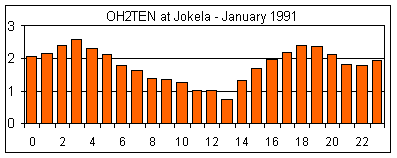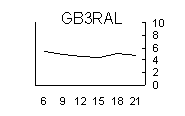 The graph opposite shows average field strengths per hour (in dB above 1 uV/m) of OH2TEN for January 1991. Vaino writes "There was one case in Jan 1991 of a remarkable 'ducting' on 28 MHz during strong tropo (to 8 dBuV/m), but otherwise, I'll bet the diurnal variations are related to variations noted on MF and LF frequencies. The ground wave component field strength is a function of air temperature and field strength follows changes in air temperature with a 3 to 4 hour lag. Winter (LF) values here are roughly 3 to 7 dB higher than summer values. On HF frequencies the variations are much smaller, around 1 to 2 dB. We can note it on a 300 kHz beacon at a ground distance of 20 km only. We tried our best to isolate various factors affecting the ground wave component strength such as change in ground loss resistance."
The graph opposite shows average field strengths per hour (in dB above 1 uV/m) of OH2TEN for January 1991. Vaino writes "There was one case in Jan 1991 of a remarkable 'ducting' on 28 MHz during strong tropo (to 8 dBuV/m), but otherwise, I'll bet the diurnal variations are related to variations noted on MF and LF frequencies. The ground wave component field strength is a function of air temperature and field strength follows changes in air temperature with a 3 to 4 hour lag. Winter (LF) values here are roughly 3 to 7 dB higher than summer values. On HF frequencies the variations are much smaller, around 1 to 2 dB. We can note it on a 300 kHz beacon at a ground distance of 20 km only. We tried our best to isolate various factors affecting the ground wave component strength such as change in ground loss resistance."
 The small graph opposite shows the average signal strength ("S" units) of observations for GB3RAL made at G0AEV in January 1998 over a path distance of 58 km. Despite the small number of observations and broader time bands used, the diurnal variations match those in OH2LX's study. Check the 10m beacon pages for other examples of beacon monitoring results.
The small graph opposite shows the average signal strength ("S" units) of observations for GB3RAL made at G0AEV in January 1998 over a path distance of 58 km. Despite the small number of observations and broader time bands used, the diurnal variations match those in OH2LX's study. Check the 10m beacon pages for other examples of beacon monitoring results.